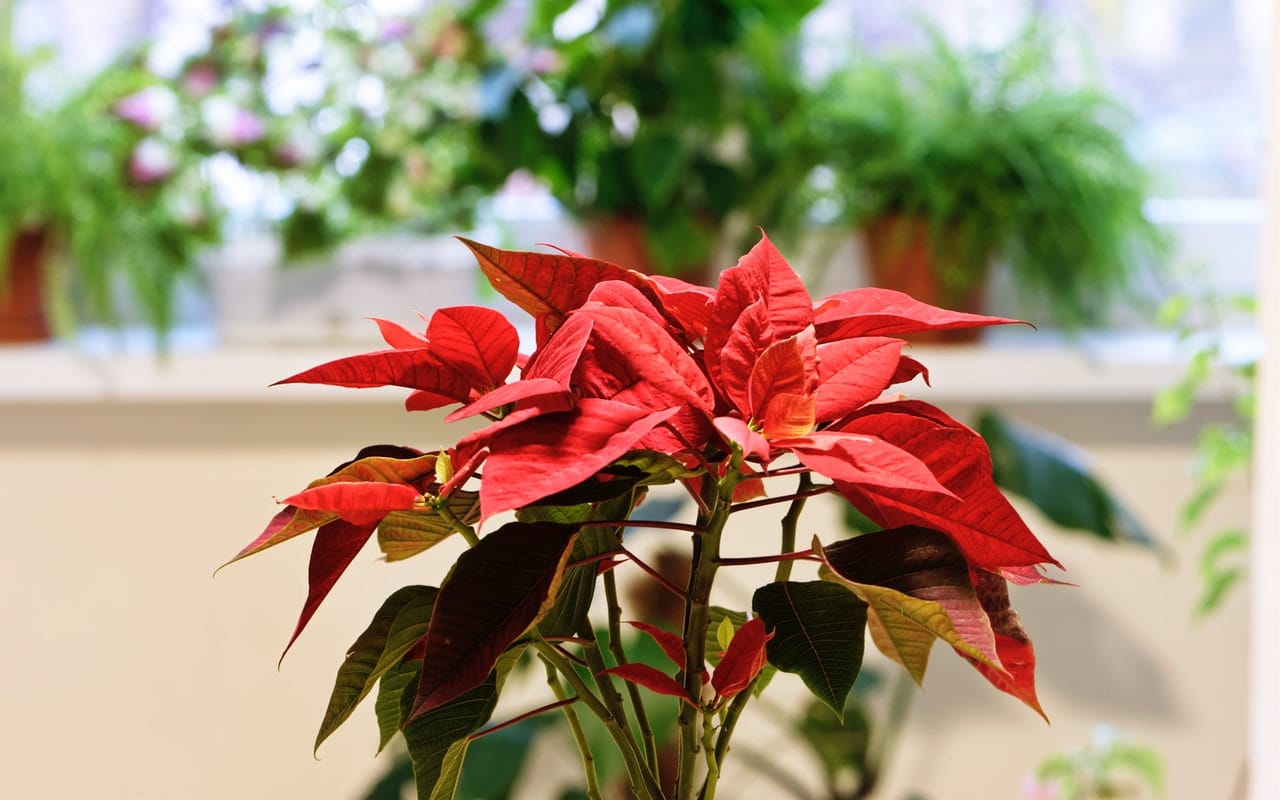Whether you are into pink poinsettias, a summer poinsettia, or natural poinsettia decoration, there’s always the right way to take care of this great plant.
How to Care for Poinsettias? How often do you water a poinsettia?
Poinsettias should be watered before the topsoil because too dry or crumbly dry, as we put it. The natural drainage of water creates the need for watering every few days. This is easier to track with potted poinsettias, as you have to wait for most of the water to drain out of the bottom of the pot. Remove any excess water from the catcher tray or plate of your poinsettia. The plant must not sit on excess water.
The frequency of watering a poinsettia plant also depends on how dry the environment is. If you live somewhere where there is barely any humidity, you may find yourself watering your indoor and outdoor plants more. Humidity contributes to the betterment of most plants as moisture exchange occurs elsewhere in the body plants too.
Why are the leaves on my poinsettia falling off?
The most common cause of falling leaves in poinsettia plants is improper watering. This can go both ways. If you are not watering your poinsettia enough, the plant will eventually dry up, and the leaves will fall off. If you are watering too much, the roots might rot and get infected, which can result in the shedding of leaves.
Remember to use the finger test on your poinsettia. Insert your finger and check if the topsoil of the pot has become chalky and dry. If it already feels chalky with almost no moisture, you need to water your plant. If there is still some moisture and the topsoil is even a little mushy, you can hold off watering it for another day or two. However, you must monitor the moisture level of all your potted plants daily. If you can’t make some concessions, your plants do not run dry, especially if you are normally busy with work.
The easiest way to water poinsettias is to lift them from the pot, place them in the sink, and water them with the faucet. Pull up the poinsettia and place it back into the pot.
Poinsettia Care Guidelines
- Poinsettias originate from Central America, which means they need a lot of suns to thrive. If you are keeping some indoors, we recommend putting the pot near a window facing where the sun rises and sets. If you live in a temperate zone, windows facing the east are best for sun-loving plants. Take note that poinsettias need direct sunlight, not in direct sunlight. You can place the poinsettia right next to the window, but keep in mind that the leaves must not touch the glass. Glass can heat up terribly during the hottest hours of the day, which can end up harming your plant.
- The environment plays a huge role in maintaining plant health. The ideal temperature range for poinsettias is 65 to 75 degrees Fahrenheit or 18 to 23 degrees Celsius. All indoor plants can become susceptible to sudden spikes or dips in temperature. The key here is to keep the plants’ environment as stable as possible so they won’t die prematurely.
- Poinsettia plants (and all other plants that belong to its class) thrive in indoor locations with plenty of sunlight. It would also be an optimal idea to perform regular misting to maintain a healthy amount of humidity. Extra humidity indoors is beneficial to both plants and humans. People with allergies tend to thrive with more humidity as the air is supportive of the lungs and the airways. Humidity also helps regulate the airflow in a given space and controls the flight of common household allergens.
- From January to March, make sure that your poinsettias get as much sunlight as they can. Watering should also coincide with the drying of the topsoil.
- In April, you can begin reducing the watering of your plants. At this point, the poinsettia can be moved to a darker room. Maintain the ideal temperature in the room where you are transferring any plant.
- Repotting is necessary for mid-May. Make sure that you put back the repotted plant near a window facing the east. East-facing windows have the best sun exposure.
- In June, you may place your poinsettia in a spot that is just partially shaded. Don’t worry; your poinsettia should still get a sufficient amount of sunlight from a partially shaded location. Take note that this spot has to be outside, not indoors.
- In July, new suckers or stems should be pinched back to about 1 inch.
- By mid-August, you can bring your poinsettia plants back inside. The spot by the window is the best; there is no need to relocate it or find a better spot.
- In September, continue watering your plants as you did the month before, but this time, apply some fertilizer to the soil. Make sure that you apply the fertilizer properly, so you don’t end up burning the roots.
- It’s important to keep your poinsettias in complete darkness from five PM to eight AM by October. Put your poinsettia back to the window side when morning comes.
- In November, you should begin seeing small flower buds. Congratulations, your poinsettia is blooming!
What is the Life Expectancy of a Poinsettia Plant?
Poinsettia plants can be tended to bloom properly for an average of two years. After two years, they will likely stop blooming. Some gardeners can be super dedicated to their plants and perform steps to extend their poinsettias for longer than two years. However, this is rare and requires the utmost diligence that can only be accomplished by a master gardener.
The two-year lifespan applies to plants that are grown outside. However, if you have interior poinsettias, it is highly likely that they will only live for a couple of months.

